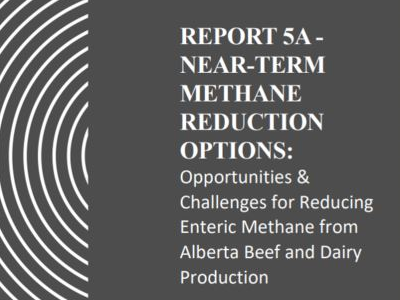Publications
The reduction of greenhouse gas emissions is a global goal across sectors. Methane, an especially potent greenhouse gas relative to carbon dioxide, is the target of the Global Methane Pledge, an undertaking by over 100 countries to reduce methane emissions by 30 percent by 2030. The agricultural sector is uniquely positioned to support Canadian methane reductions through mitigation of enteric fermentation in cattle. Enteric fermentation in dairy and beef cattle contribute to over 85 percent of methane emissions from the agriculture sector. Different mitigation strategies and technologies have demonstrated variable effect on methane reduction, depending on factors related to cattle diet, management, and operational practices. Relevant research and literature based on criteria related to potential application in western Canada and Canadian cattle production in the beef are dairy sector was collected and reviewed using PRISMA approach. Research in the beef and dairy sector were divided and compiled into separate databases to determine the most effective and impactful mitigation strategies. Overall, the use of 3NOP and marine algal strains as dietary additives were identified as the most promising technologies in reducing enteric fermentation, without negatively impacting production markers and subsequent profit. Tanniferous legumes as a forage also shows promise, however current findings in research demonstrate mixed effects on various production markers in dairy and beef cattle. Other mitigation strategies identified through the review process, including the use of various natural and synthetic dietary additives, require further investigation as inconclusive and insignificant results are predominant. To drive adoption of methane reduction strategies by farmers, introduction of the mitigation technologies and strategies discussed must align with Federal and Provincial policy development and implementation and ensure sufficient profit to producers, potentially through the sale of carbon offsets as the market development, in order to cover additional costs of adoption and incentivise use. Prompt introduction and adoption of the mitigation strategies discussed can effectively reduce enteric methane emissions in Canadian cattle herds, propelling Canada towards the 30 percent emission reduction goal in time for 2030.
Saturday, April 30, 2022
Courtney Kowk, Elena Vinco
Joshua Bourassa and Elena Vinco
Thursday, April 21, 2022
Joshua Bourassa and Elena Vinco
Thursday, April 21, 2022
Nimanthika Lokuge and Sven Anders
Thursday, April 14, 2022
Caitland Reynolds, Rachelle Drummond, Elena Vinco, Guillaume Lhermie
Monday, January 31, 2022
Simpson Centre Blog
Thursday, January 27, 2022
Karen Spencer


